Application of an Automated Discharge Imaging System and LSPIV during Typhoon Events in Taiwan
Abstract
:1. Introduction
2. Materials and Methods
2.1. Description of the Study Area
2.2. ADIS Hardware System
2.3. ADIS Software System
- (i) Image Calibration
- (ii) Image Mapping
- (iii) Velocity Measurement
- (iv) Discharge Calculation
3. Results and Discussion
3.1. Comparison of Surface Velocity from Different Instruments
3.2. Comparison Surface Velocity and Water Level during Typhoon Event
3.3. Index Velocity
3.4. Discharge Estimation
3.5. Sensitivity Analysis
4. Conclusions
Acknowledgments
Author Contributions
Conflicts of Interest
References
- Buchanan, T.J.; Somers, W.P. Discharge measurements at gauging station: U.S. geological survey techniques of water-resources investigations. In Technical Reports; U.S. Geological Survey: Reston, VA, USA, 1969. [Google Scholar]
- Tauro, F.; Selker, J.; van de Giesen, N.; Abrate, T.; Uijlenhort, R.; Porfiri, M.; Manfreda, S.; Caylor, K.; Moramarco, T.; Benveniste, J.; et al. Measurements and observations in the XXI century (MOXXI): Innovation and multidisciplinary to sense the hydrological cycle. Hydrol. Sci. J. 2018, 63, 169–196. [Google Scholar] [CrossRef]
- Rantz, S.E. Measurement and computation of streamflow. Measurement of Stage and Discharge. In Water-Supply Paper 2175; U.S. Geological Survey: Washington, DC, USA, 1982; Volume 1. [Google Scholar]
- Lang, M.; Ponanz, K.; Renard, B.; Renouf, E.; Sauquet, E. Extrapolation of rating curves by hydraulic modeling, with application to flood frequency analysis. Hydrol. Sci. J. 2010, 55, 883–989. [Google Scholar] [CrossRef]
- Coata, J.; Cheng, R.; Haeni, F.; Melcher, N.; Spicer, K.; Hayes, E.; Plant, W.; Hayes, K.; Teague, C.; Barrick, D. Use of radars to monitor stream discharge by noncontact method. Water Resour. Res. 2006, 40, 14. [Google Scholar]
- Fujita, I.; Muste, M.; Kruger, A. Large-scale particle image velocimetry for flow analysis in hydraulic engineering applications. J. Hydraul. Res. 1998, 36, 397–414. [Google Scholar] [CrossRef]
- Creutin, J.D.; Muste, M.; Bradley, A.A.; Kim, S.C.; Kruger, A. River gauging using PIV techniques: A proof of concept experiment on the Iowa River. J. Hydrol. 2003, 277, 182–194. [Google Scholar] [CrossRef]
- Jodeau, M.; Hauet, A.; Paquier, A.; Le Coz, J.; Dramais, G. Application and evaluation of LS-PIV technique for the monitoring river surface velocities in high flow conditions. Flow Meas. Instrum. 2008, 19, 117–127. [Google Scholar] [CrossRef] [Green Version]
- Hauet, A.; Kruger, A.; Krajewski, W.F.; Bradley, A.; Muste, M.; Creutin, J.D. Experiment system for real-time discharge estimation using an imagine-based method. J. Hydrol. Eng. 2008, 13, 105–110. [Google Scholar] [CrossRef]
- Muste, M.; Fujita, I.; Hauet, A. Large-scale particle image velocimetry for measurements in riverine environments. Water Resour. Res. 2008, 44. [Google Scholar] [CrossRef]
- Sun, X.; Shiono, K.; Chandler, J.H.; Rameshwaran, P.; Sellin, H.J.; Fujita, I. Discharge estimation in small irregular river using LSPIV. Proc. Inst. Civ. Eng. Water Manag. 2010, 163, 247–254. [Google Scholar] [CrossRef] [Green Version]
- Tsubaki, R.; Fujita, I.; Tsutsumi, S. Measurement of the flood discharge of a small-sized river using an existing digital video recording system. J. Hydro-Environ. Res. 2011, 5, 313–321. [Google Scholar] [CrossRef]
- Bechle, A.; Wu, C.H.; Liu, W.C.; Kimura, N. Development and application of an automated river-estuary discharge imaging system. J. Hydraul. Eng. ASCE 2012, 138, 27–339. [Google Scholar] [CrossRef]
- Dobson, D.W.; Holland, K.T.; Calantoni, J. Fast, large-scale, particle image velocimetry-based estimations of river surface velocity. Comput. Geosci. 2014, 70, 35–43. [Google Scholar] [CrossRef]
- Tauro, F.; Olivieri, G.; Petroselli, A.; Porfiri, M.; Grimaldi, S. Flow monitoring with a camera: A case study on a flood event in the Tiber River. Environ. Monit. Assess. 2016, 188, 118. [Google Scholar] [CrossRef] [PubMed]
- Tauro, F.; Petroselli, A.; Porfiri, M.; Giandomenico, L.; Bernardi, G.; Mele, F.; Spina, D.; Grimaldi, S. A novel permanent gauge-cam station for surface-flow observations on the Tiber River. Geosci. Instrum. Methods Data Syst. 2016, 5, 241–251. [Google Scholar] [CrossRef]
- Tauro, F. Particle tracers and image analysis for surface flow observations. WIREs Water 2016, 3, 25–39. [Google Scholar] [CrossRef]
- Hauet, A.; Muste, M.; Ho, H.C. Digital mapping of riverine waterway hydrodynamic and geomorphic features. Earth Surf. Proc. Land. 2009, 34, 242–252. [Google Scholar] [CrossRef]
- Kantoush, S.A.; Schleiss, A.J. Channel formation during flushing of large shallow reservoirs with different geometries. Environ. Technol. 2009, 30, 855–863. [Google Scholar] [CrossRef] [PubMed]
- Le Coz, J.; Hauet, A.; Pierrefeu, G.; Dramais, G.; Camenen, B. Performance of imagine-based velocimetry (LSPIV) applied to flash-flood discharge measurements in Mediterranean rivers. J. Hydrol. 2010, 394, 542–552. [Google Scholar] [CrossRef]
- Wanek, J.M.; Wu, C.H. Automated trinocular stereo imaging system for three-dimensional surface wave measurements. Ocean Eng. 2006, 33, 723–747. [Google Scholar] [CrossRef]
- Wolf, P.; DeWitt, B. Elements of Photogrammetry: With Applications in GIS; McGraw-Hill: Boston, MA, USA, 2000. [Google Scholar]
- Holland, K.T.; Holman, R.A.; Lippmann, T.C.; Stanley, J.; Plant, N. Practical use of video imagery in nearshore oceanographic field studies. IEEE J. Ocean. Eng. 1997, 22, 81–92. [Google Scholar] [CrossRef]
- Mei, C.C. The Applied Dynamics of Ocean Surface; World Science: Singapore, 1989. [Google Scholar]
- Harpold, A.A.; Mostaghimi, S.; Vlachos, P.P.; Brannan, K.; Dillaha, T. Stream discharge measurement using Large-Scale Particle Image Velocimetry (LSPIV) prototype. Trans. ASABE 2006, 49, 1791–1805. [Google Scholar] [CrossRef]
- Herschy, R. Streamflow Measurement; Taylor & Francis: New York, NY, USA, 2009. [Google Scholar]
- Gunawan, B.; Sun, X.; Sterlingm, M.; Shiono, K.; Tsubaki, R.; Rameshwaran, P.; Knight, D.W.; Chandler, J.H.; Yang, X.; Fujita, I. The application of LS-PIV to a small irregular river for inbank and overbank flows. Flow Meas. Instrum. 2012, 24, 1–12. [Google Scholar] [CrossRef] [Green Version]
- Daigle, A.; Berube, F.; Bergeron, N.; Matte, P. A methodology based on particle image velocimetry for river ice velocity measurement. Cold Reg. Sci. Technol. 2013, 89, 36–47. [Google Scholar] [CrossRef]
- Patalano, A.; Garcia, C.M.; Brevis, W.; Bleninger, T.; Guillen, N.; Moreno, L.; Rodriguez, A. Recent advances in Eulerian and Lagragian large-scale particle image velocimetry. In Proceedings of the 36th IAHR World Congress, The Hague, The Netherlands, 26 June–3 July 2015; pp. 1–6. [Google Scholar]
- Polatel, C. Indexing free-surface velocity. In Proceedings of the a Prospect for Remote Discharge Estimation, Paper Presented at 31st Congress, International Association of Hydraulic Engineering and Research, Seoul, Korea, 11–16 September 2005. [Google Scholar]
- Dramais, G.; Le Coz, J.; Camenen, B.; Hauet, A. Advantages of a mobile LSPIV method for measuring flood discharges and improving stage-discharge curves. J. Hydro-Environ. Res. 2011, 5, 301–312. [Google Scholar] [CrossRef]
- Muste, M.; Ho, H.C.; Kim, D. Consideration on direct stream flow measurements using video imagery: Outlook and research needs. J. Hydro-Environ. Res. 2011, 5, 289–300. [Google Scholar] [CrossRef]
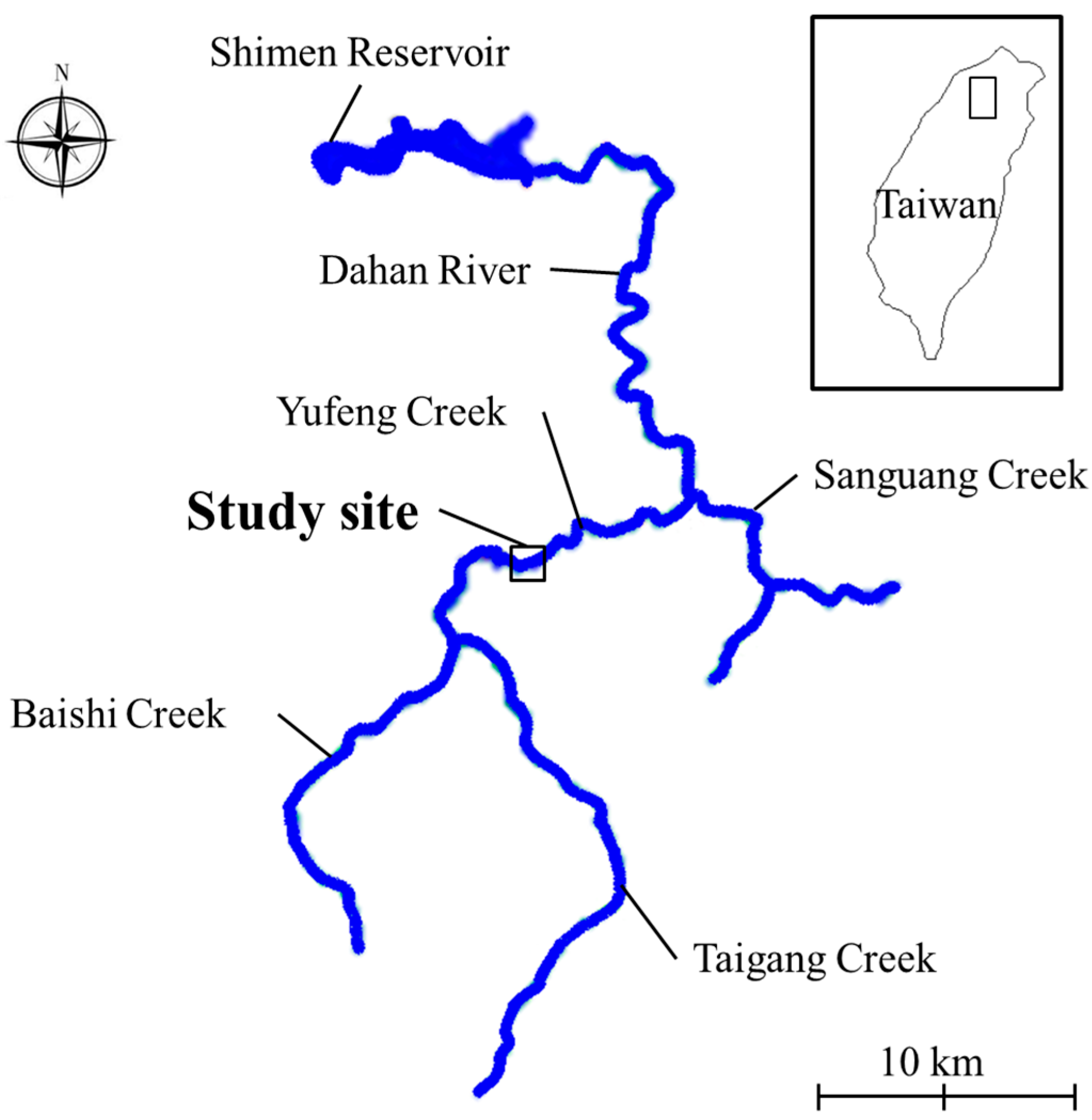
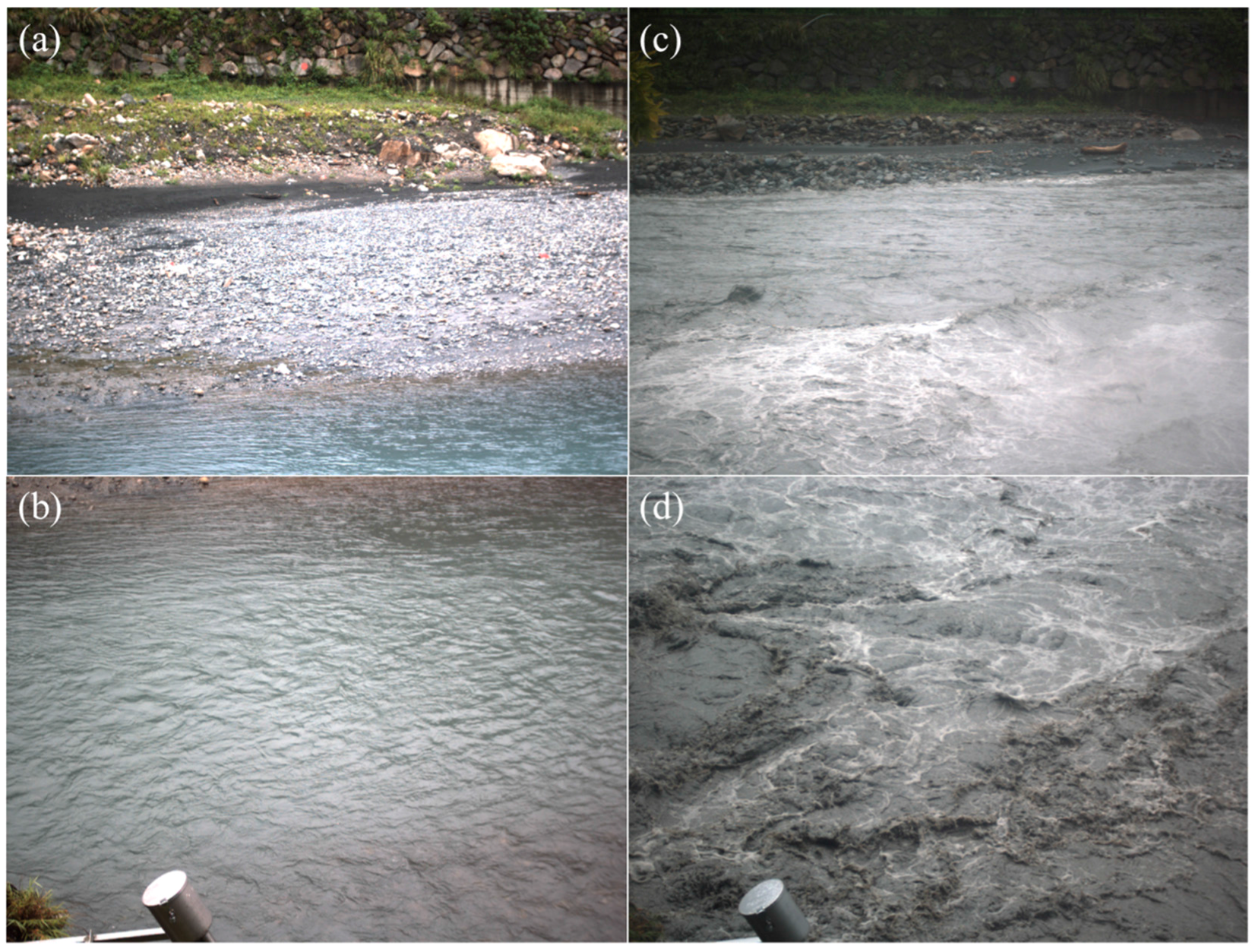



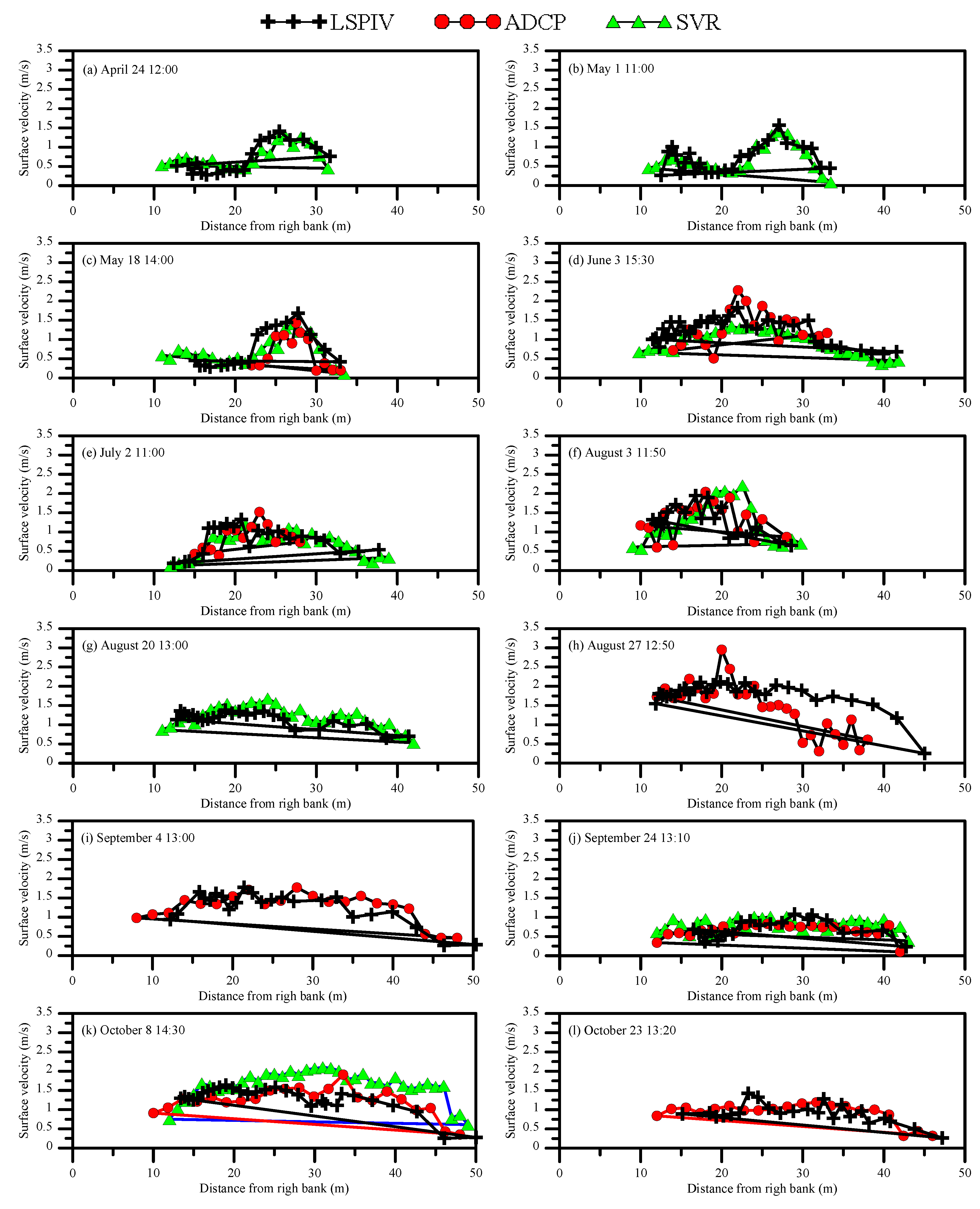
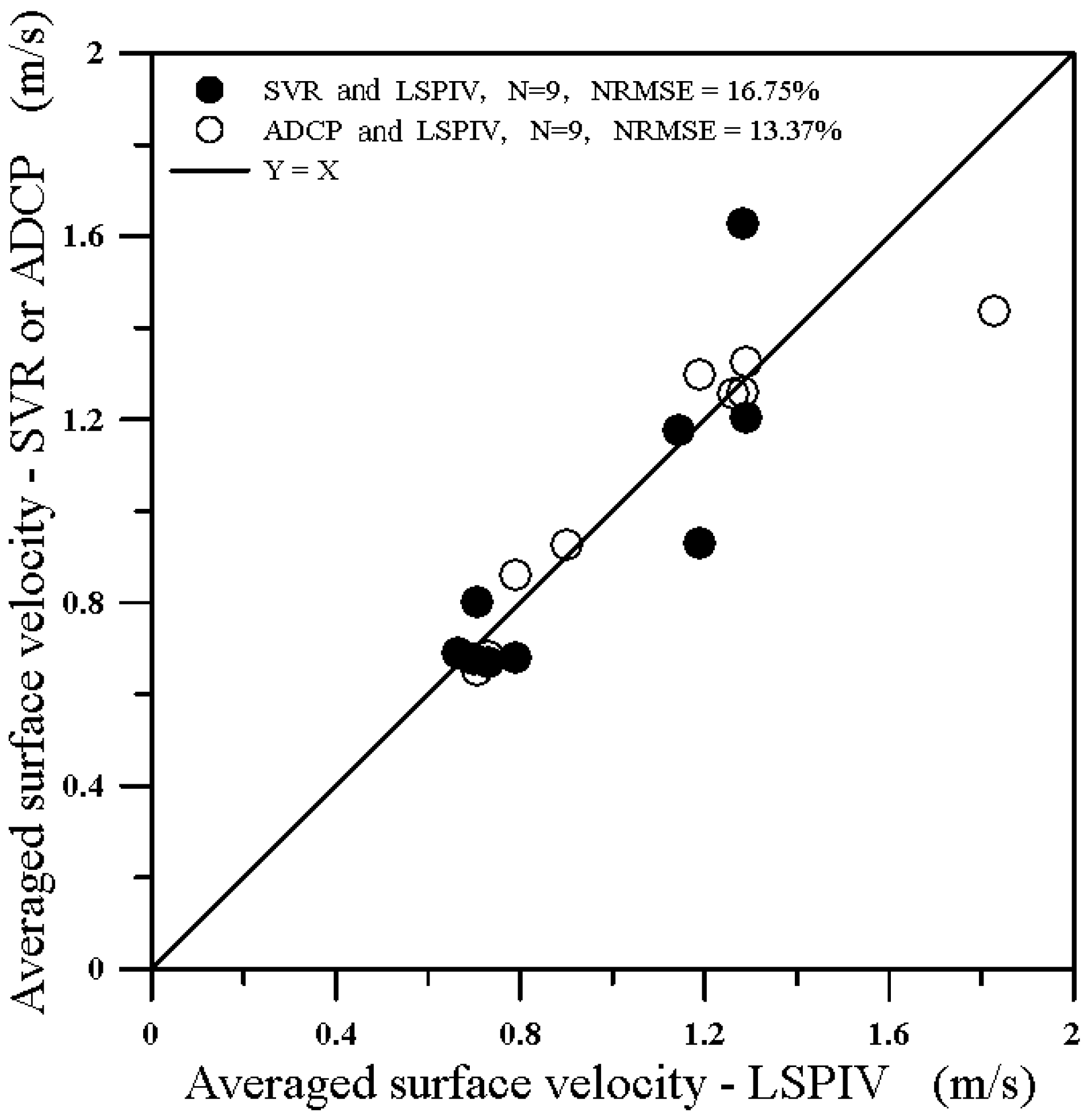
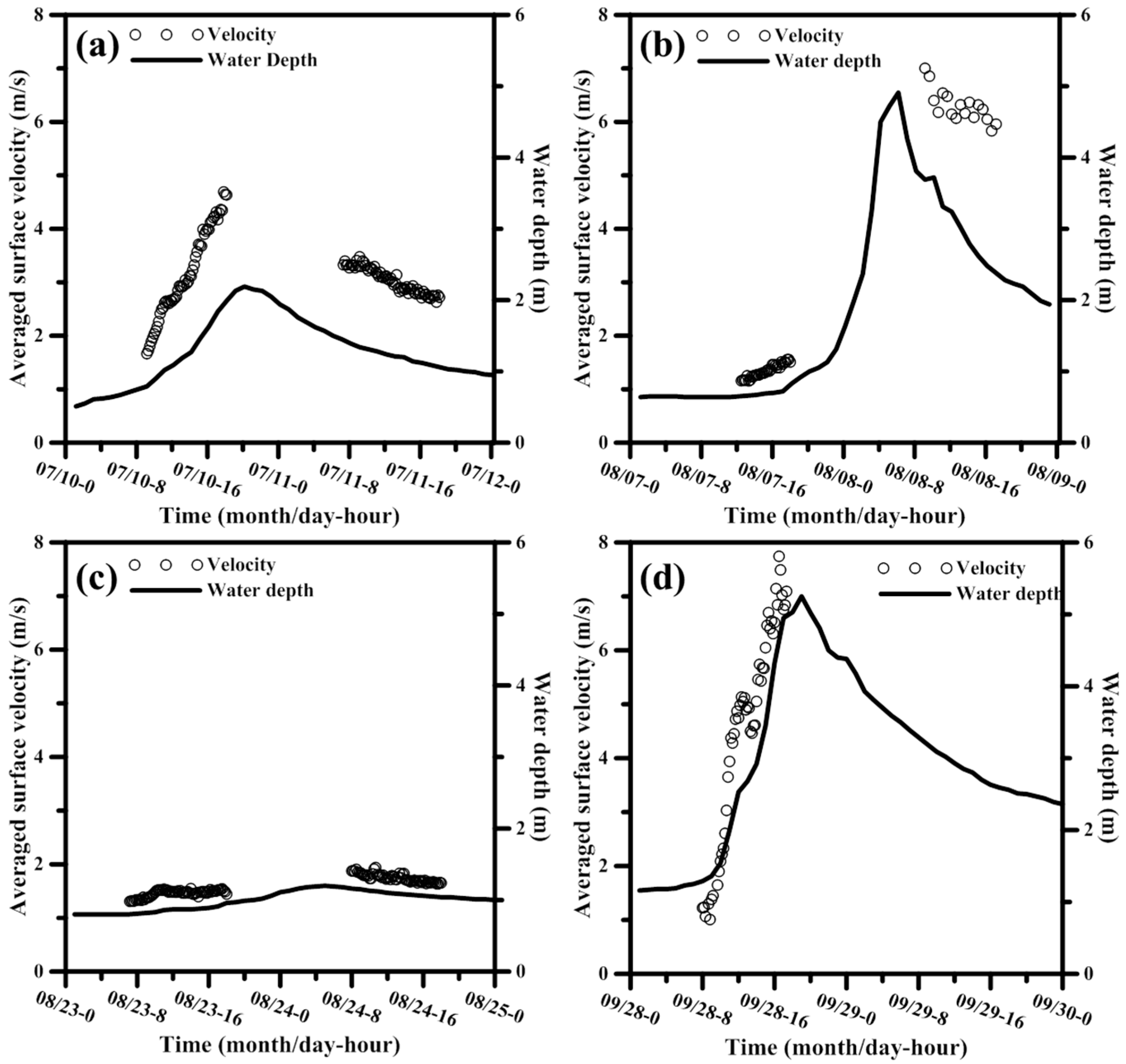
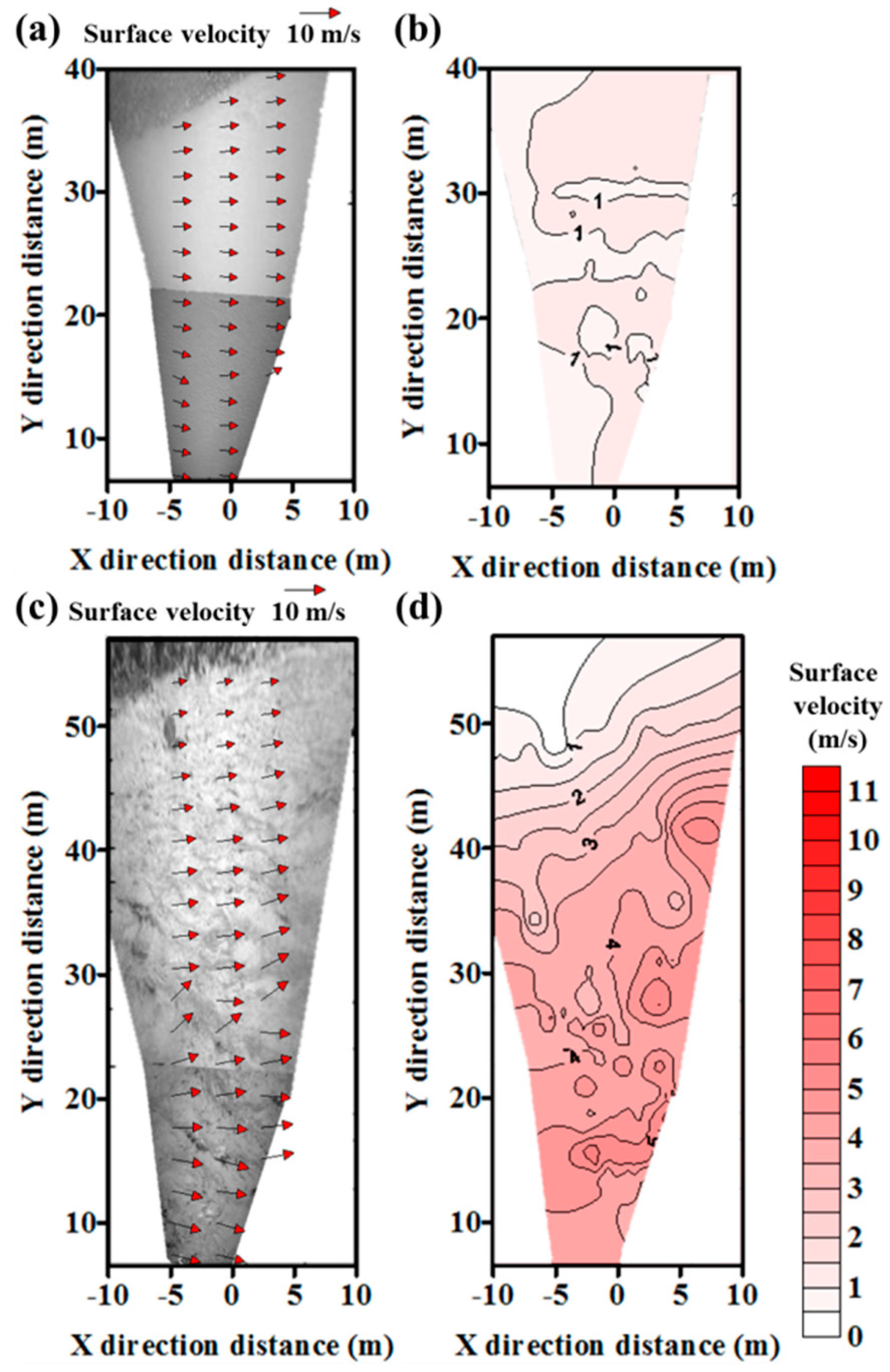


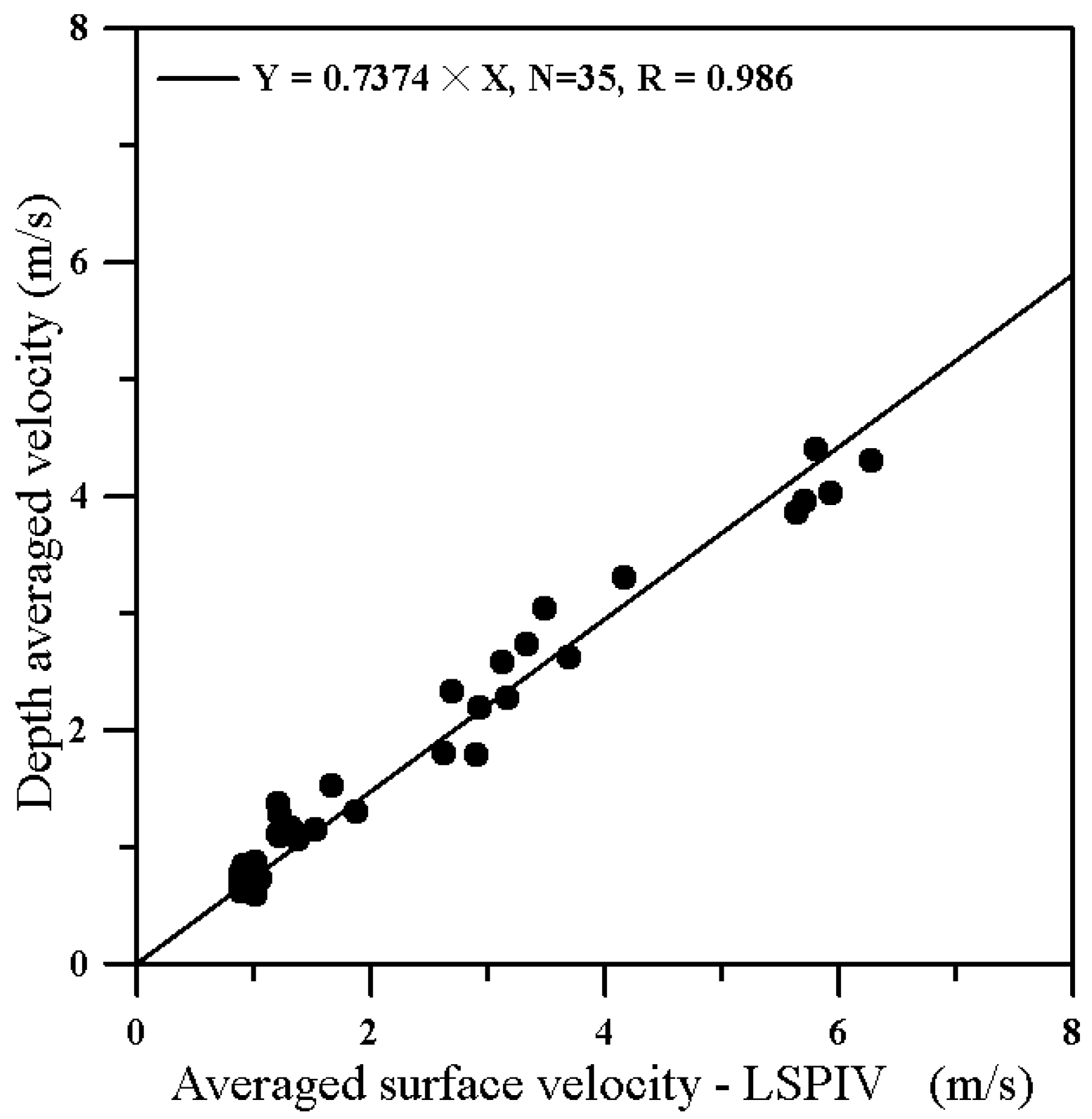

| Parameter | Right Camera | Left Camera | Rate of Change (RC) of Surface Velocity Using LSPIV (%) | |
|---|---|---|---|---|
| Parameter Used at Right and Left Cameras Increases 10% | Parameter Used at Right and Left Cameras Decreases 10% | |||
| uc (pixel) | 800 | 800 | −0.56 | 0.57 |
| vc (pixel) | 600 | 600 | 10.14 | −7.67 |
| d (m) | 0.0147 | 0.0168 | −7.77 | 10.44 |
| α (degree) | 2.44 | −1.98 | 0.00 | 0.00 |
| τ (degree) | 115.86 | 98.22 | −49.67 | 294.75 |
| θ (degree) | 178.15 | 178.94 | 84.11 | −110.67 |
| xc (m) | 0.230 | −0.091 | 0.00 | 0.00 |
| yc (m) | 1.056 | 1.622 | 0.00 | 0.00 |
| zc (m) | 1.785 | 1.738 | 2.23 | −2.23 |
| Measured Date in Year 2015 | Averaged Surface Velocity (m/s) | ||||
|---|---|---|---|---|---|
| LSPIV (A) | ADCP (B) | SVR (C) | |||
| 24 April, 12:00 | 0.663 | -- | 0.691 | -- | 0.028 |
| 1 May, 11:00 | 0.698 | -- | 0.675 | -- | 0.023 |
| 18 May, 14:00 | 0.73 | 0.682 | 0.67 | 0.048 | 0.06 |
| 3 June, 15:30 | 1.189 | 1.3 | 0.929 | 0.111 | 0.26 |
| 2 July, 11:00 | 0.79 | 0.861 | 0.679 | 0.071 | 0.111 |
| 3 August, 11:50 | 1.291 | 1.325 | 1.206 | 0.034 | 0.085 |
| 20 August, 13:00 | 1.144 | -- | 1.178 | -- | 0.034 |
| 27 August, 12:50 | 1.827 | 1.437 | -- | 0.39 | -- |
| 4 September, 13:00 | 1.26 | 1.256 | -- | 0.004 | -- |
| 24 September, 13:10 | 0.706 | 0.654 | 0.8 | 0.052 | 0.094 |
| 8 October, 14:30 | 1.283 | 1.26 | 1.628 | 0.023 | 0.345 |
| 23 October, 13:20 | 0.9 | 0.928 | -- | 0.028 | -- |
© 2018 by the authors. Licensee MDPI, Basel, Switzerland. This article is an open access article distributed under the terms and conditions of the Creative Commons Attribution (CC BY) license (http://creativecommons.org/licenses/by/4.0/).
Share and Cite
Huang, W.-C.; Young, C.-C.; Liu, W.-C. Application of an Automated Discharge Imaging System and LSPIV during Typhoon Events in Taiwan. Water 2018, 10, 280. https://doi.org/10.3390/w10030280
Huang W-C, Young C-C, Liu W-C. Application of an Automated Discharge Imaging System and LSPIV during Typhoon Events in Taiwan. Water. 2018; 10(3):280. https://doi.org/10.3390/w10030280
Chicago/Turabian StyleHuang, Wei-Che, Chih-Chieh Young, and Wen-Cheng Liu. 2018. "Application of an Automated Discharge Imaging System and LSPIV during Typhoon Events in Taiwan" Water 10, no. 3: 280. https://doi.org/10.3390/w10030280





